Survey Guide to Insurance Surveys
by David Pascoe
Introduction
The insurance survey, Condition and Value survey or C&V as it is often referred to, is a type of survey intended for use by insurance companies for evaluating whether or not they wish to insure a particular vessel. For over 30 years surveyors have been providing this type of survey. But, unfortunately, the insurance industry has never set a standard as to the nature and extent of information that they require, and so surveyors have largely been left to guess at the kind of information that different insurance companies want. This guide will assist the surveyor in identifying the most appropriate information to be covered in the survey and report.
Insurance surveys can also serve as an appropriate format when lending institutions request "appraisals." While there is no commonly accepted format for anyone who requests an appraisal, but the insurance survey format fills this purpose quite well.
C&V Defined:
An insurance survey is a limited form of survey that is intended to assist insurance underwriters in making underwriting decisions. The survey has two primary purposes: (1) to identify the vessel, its equipment, condition and general value, and (2) to identify defects, damages or hazardous conditions that pose a potential threat to the safety of the vessel and its passengers, or any other such condition that is likely to result in loss or damage. Insurance surveys should never be provided to a client who is purchasing a vessel for the purpose of making a purchase decision.
A report format consisting of both a pre designed form and narrative description is recommended. It is fundamental to a proper survey report that the surveyor should clearly state in a narrative format or by an appropriate form all such areas which were inspected and which were not inspected. While underwriters don't particularly like forms, and often complain about them, forms serve a very important function for surveyors. First, the form serves as a guideline to insure that all major areas of concern are covered. Second, the form records necessary information and serves as verification that these major areas were inspected.
Insurance surveys are not intended to certify that a vessel is built, or conforms to, any standard or standards set by any official standards organization. Standards such as the ABYC Standards for Small Craft and NFPA 302 Pleasure and Commercial Motor Craft are voluntary standards. While most reputable builders make an effort to comply, others do not. Surveyors must use their own judgment when making reference or recommendations for compliance, based on the surveyor's perception of hazard.
It should be remembered that the surveyor's report is his work product. It is the one example that illustrates to the industry the degree of his professionalism and competence It is from his reports that his work will be judged. Survey reports are often seen by many people, not only in the present, but often far into the future. It reflects his competence and constitutes one of his best forms of advertising. Therefore, the surveyor should strive to produce a report that meets the highest professional standards. This guide is intended to assist the surveyor in achieving that goal.
Insurance surveys should contain the following information:
- A statement of the purpose of the survey
- Date and location of survey plus status of vessel either afloat or hauled
- Builder, model (if any), and year of construction completion
- Vessel type, such as flying bridge sport fisherman, open fisherman, aft cockpit sloop, center cockpit ketch, etceteras.
- Identifiers should include hull number, registration number and engine serial numbers
- Specifications should include principle dimensions, machinery parameters such as model number, horsepower, turbo charged, transmissions, etc., plus fuel capacities
A general statement describing the vessel, whether its production or custom built, major alterations, additions or refits, major builder add-ons such as bait & tackle centers, towers, custom tops, exterior seating arrangements or any other major features that significantly affect the value of the vessel.
Equipment inventories should include only items of significant value or aggregations of smaller items that add up to substantial value. The creation of long lists describing everything on the vessel should be avoided. Underwriters neither want nor appreciate this. Comments on the presence of fine arts, large amounts of personal effects, the presence of unusual items such as computers, costly decoration or any other items of significant value. This is useful to insurance companies in the event of claims, and to help assess value.
CATEGORIES TO BE CONSIDERED
Construction: A general statement describing the hull construction and superstructure is generally all that is necessary for most production built vessels, unless the nature of the construction or design is unusual or unique. It is important for underwriters to know if a vessel is built of exotic, unusual or experimental designs or materials, or whether it is an unusual or experimental design. It is generally not necessary to describe in great detail the scantlings of the hull such as dimensions and spacing of frames and stringers, etc. It is sufficient to state that the hull is lightly, moderately or heavily built without going into great detail, unless there is a real need to do so.
Cockpit Designs: Sport fishing vessels and other vessels with cockpits that are particularly low to the water line should be inspected for the potential of sinking the vessel should there be a significant change in trim, heavy rain storms or other adverse conditions.
Propulsion Machinery: Particularly for motor vessels, the propulsion machinery constitutes a major part of the vessel's value and therefore deserves careful attention by the surveyor.
- Model & serial numbers
- Engine hours or approximate age
- Overhaul dates if known
- Apparent condition of exhaust risers
- Whether exhaust risers are of adequate height to prevent backsurge
- Visual condition of exhaust piping and mufflers
- Fire protection of non water cooled exhaust systems
- Condition of belts, hoses and engine wiring
- Inspect connections of throttle and shift control cables
- Stuffing boxes tight or leaking
- Existence of significant fuel, oil or coolant leaks
- Presence of water or exhaust temperature alarms
- Presence of neutral safety switch (engine won't start in gear)
- Potential for carbon monoxide hazard to passengers from gas engines
Auxiliary Machinery & Generators:
- Generally same information as propulsion machinery
- Name, model and serial number if possible
- Carbon monoxide hazard with gas generators
Equipment that should be tested and proved operational:
- Bilge pumps, number and capacity
- Navigation lights & horn
- Steering system
- Engine controls
Fuel System: A General Description of the fuel tankage, fuel lines, fill system, valves and filters should be given either in narrative or a form. Fuel systems have the potential for fire, explosion and pollution hazards so that the integrity of these systems should be dealt with in detail.
Compliance with ABYC H-24 should be considered mandatory for gasoline systems.
Condition of gasoline fuel tanks, particularly foamed in place aluminum tanks, should be reported. If tanks are not accessible, that should be so stated in the report.
Electrical Systems: While it is not possible to survey an electrical system to a standard such as ABYC or NFPA-302, basic compliance of the fundamental system safety features of both AC and DC systems should be considered and referenced when possible. Reports should describe the basic system design and circuit protection. It is recommended that AC system polarity be checked.
Cooking Facility: Compliance with ABYC section A-1 should be considered mandatory for LPG systems and section A-22 for CNG systems. Section A-3 compliance is recommended for electric systems. The presence of flammable or unprotected materials around the stove should be reported.
Plumbing Systems: Should be inspected with a view toward the water tight integrity of all sea water systems. This means that materials should be highly corrosion resistant and systems designed in such a way as to avoid hazards for reverse siphoning, especially for such things as cockpit drains, bait and fish wells, shower and bilge pumps.
Type & quality of sea cocks, strainers and hoses on all through hull systems
Bilge pumps, bait wells, heads, shower pans and sumps should be checked for reverse siphoning potential.
Piping and hoses should be of good quality and be adequate supported, properly joined and free of dissimilar or highly corrosive materials such as iron, steel, aluminum and raw copper. All deficiencies should be reported.
Safety Equipment: It is mandatory that a vessel meet U.S.C.G. requirements for safety equipment as these are statutory requirements. The survey should contain a detailed itemization of the equipment, the dates of inspection or reinspection (such as for life rafts, fire equipment and emergency transmitters), and notation of whether vessel is in compliance.
Basic Vessel Design: Statements as to seaworthiness can only be made in the negative since seaworthiness is a relative term. The following are some relevant issues to be considered:
Is vessel suitable for the area where being used? Note any limitations or recommended restrictions on use. Examples would be inland houseboats near oceans, sailing vessels lacking adequate auxiliary power in areas of strong tides or currents, vessels with low power or poor maneuverability on swift flowing rivers.
Are decks safe with adequate hand railings or hand holds? Are there unsafe features that could cause bodily injury such as badly designed flying bridge ladders or lack of railings on an upper deck? Are the cockpit deck and drain scuppers properly designed and of sufficient height above water line to prevent inadvertent sinking, particularly outboards and other small craft with low, open cockpits?
Are doors, windows, hatches and portholes suitable for marine use? Do all openings have a provision for locking from the interior? Are locks of good quality or are they easily broken? This is some of the information that underwriters find useful for assessing risk.
General Considerations:
Reports should be prepared and written in such a way as to indicate that all basic systems either were or were not inspected. For example, when a gasoline fuel system is inspected for condition and leaks, the report should say so. Otherwise, the reader can rightly assume that the system wasn't checked if the report does not so indicate.
A good survey report is one that indicates that all systems of major importance were either inspected and the condition noted, or it indicates that the system, or parts thereof, were not accessible for inspection. The surveyor lets the reader know what he has done, or was not able to accomplish. It does not reflect poorly on the surveyor to state that something wasn't, or couldn't be inspected or tested. On the contrary, to do so is a sign of integrity and thoroughness in reporting.
Describing Conditions:
Because surveyors are dealing with the property of others, they have to be careful what they say and avoid injurious remarks or generally insult the vessel owner. There is a fine line to be walked between accurately portraying the condition of the vessel and describing things in such a way as to invite controversy. Remember the adage that one man's trash is another man's treasure.
If the surveyor has been attentive to detail, making diligent note of all substandard conditions, he won't find it necessary to make sweeping generalizations about the overall condition. The itemization of substandard conditions and defects will generally serve to size up the whole.
However, conditions such as high wear and tear, lack of maintenance, uncleanness, clutter and disorganization reflect more than just the value of the vessel. It may reflect the owner's state of mind and financial condition and have a direct bearing on risk assessment. Such conditions deserve comment, but should be made with discretion.
Example "The interior of a vessel shows heavy wear and tear, poor housekeeping and is generally dirty and unkempt with excessive accumulated unsecured clutter." Instead of using this description, state: "Interior shows above average wear and tear and requires improvements in housekeeping and removal of clutter and stowage of all loose items to ensure safety at sea." While not stating outright that the vessel is a terrible mess, it does allow the underwriter to read between the lines and form an accurate impression while reducing the risk of the surveyor insulting his client. After all, if the owner paid the surveyor, it is the owner who is the client.
Language & Terminology:
Consider that the end users of survey reports may not have a marine technical background. Survey reports should not be pedantic, but written in as common language as possible while maintaining professionalism and referring to appropriate marine terminology.
Avoid ambiguous words and phrases such as "proper," "good marine practice," "safe," "certified," "approved" and "qualified marine technician", without describing what these terms mean. Certified or approved by whom? Qualified by whom? Proper according to whom or what standard? If a particular standard must be met, describe or provide a copy of the relevant standard. Otherwise simply state, "repair or restore to original condition" since the prior condition will be obvious.
Reporting Style and Length:
Judging by the length and numerous pages of many reports, some surveyors apparently feel that the more pages a report contains, the more thorough the report will appear. Perhaps, but busy underwriters may have to review many reports every day. They will be more appreciative of the surveyor who understands what information is needed and is able to convey that with an economy of words and paper.
Long, flowery descriptions of the vessel, its systems and equipment should be avoided, particularly for production built boats, or boats built of conventional materials and design. Custom or foreign built boats which are likely to be unknown to the underwriter deserve additional description that should be brief and to the point.
The most important feature of the report is that it should be well organized and concise. Nearly all end users prefer letter size pages rather than legal size so that the report doesn't have to be folded to fit into a file. Report covers are not necessary and will be discarded when the report is placed in the underwriters file. It is perfectly acceptable, and probably preferable, for the surveyor to provide his report unbound.
Narrative reports should be categorical. Reports using a form to record vital information can omit detailed descriptions and go straight to describing in a narrative only that which isn't recorded on the form. Form design should be simple and easy to read. If it's more than three one-sided A-4 pages, its probably too long. Forms are only useful for recording general data and should not be used to describe deficiencies or condition. Comments on condition are best dealt with in the narrative.
Describe conditions and recommendations completely. Avoid the use of linguistic short hand or unnecessarily abbreviated descriptions. Pages should be numbered similar to "Page 1 of 7" so that end user will know whether all pages have been received.
Vessel Security:
The security of the dock or mooring location of a vessel is often of major importance to underwriters, although few actually request this information. However, many surveyors include information on the security of the marina or dock against wakes of passing vessels, tides, floods on rivers, storms, hurricanes and theft risks. Poorly constructed docks, inadequate mooring lines, pilings that are not adequate for the tidal range are among the things to be considered.
Theft risk is another important consideration. Interior security was already mentioned, but what about unsecured electronics, dinghies and outboard motors that could easily be stolen. These are all appropriate considerations for the insurance survey.
Summaries:
Summaries are generally not necessary but can be useful particularly for sizing up vessels that are in particularly good condition or are otherwise unique or out of the ordinary. The use of superlatives such as excellent, A-1, first class or Bristol condition should be avoided unless accompanied by a description or facts supporting such superlatives. There is no universal agreement on what these terms mean so that their use should be justified.
Surveyors should not make statements such as "this vessel is considered to be a good marine insurance risk." Surveyors are not underwriters and they have no basis for making such statements and should avoid doing so. A simple reference as to whether the vessel appears to be suitable for its intended use, and whether there are conditions which affect the safety of the vessel are sufficient.
References to condition can usually be effectively handled by making a statement about the general level of wear and tear - high, low, medium, or average, below or above average, are statements that allow the surveyor to paint the picture without resorting to harsh or insulting words. Example: The interior upholstery and carpet shows heavy wear. Or , exterior finish is oxidized and shows numerous abrasions and scratches. Conversely: Exterior finish shows a high gloss and is lacking in normal wear and tear.
Rating Systems - a few surveyors employ rating systems to evaluate the overall condition. Since there is no universally agreed standard, the use of such systems should be avoided. The interior, exterior and machinery will often be found to have different levels of maintenance and it is appropriate to summarize each category separately.
Avoid references to "cosmetic condition." There is no standard definition of what this means. Instead, refer directly to the individual condition of such things as gelcoat, paint, varnished woods, hardware, upholstery, carpet and the like.
Recommendations:
When receiving a survey report, most likely the first thing the underwriter will look at is the Recommendations section, for this is the section that tells him most about the condition and insurability of the vessel. The recommendations section should consist of statements of fact pertaining to any and all deficient, substandard or dangerous conditions as would affect the safety and seaworthiness of the vessel or its passengers. The recommendations should include a statement of generally how a deficient condition should be restored to acceptable condition.
The most common shortcoming found in surveys is the failure to describe a defect sufficiently. The surveyor should take good notes and describe the condition fully, including the potential results of failure to correct the condition.
Priority Recommendations: Underwriters often like surveyors to indicate and highlight any such defects that affect the immediate safety of the vessel. It is useful to them for surveyors to prioritize in terms of "immediate," 30, 60 or 90 day time frames to complete the correction, based on the surveyor's assessment of the hazard.
It is also acceptable for the surveyor to make recommendations or "suggestions" that are not mandatory. These can include such things as installing a bilge high water alarm or better locks on a door or hatch where there is no standard or mandate that the owner do so, but where the surveyor believes it is a reasonable precaution.
Photographs:
It is recommended that six (6) photographs of the vessel should be provided, unless there is a demonstrable need for more. These should include: exterior profile and frontal or stern view; one or two views of the interior; engine room/machinery space; plus photos of any major defects that seriously affect the safety of the vessel. When making recommendations that will involve a major expense to the owner, it is wise to have good photographic documentation.
These are the photographs that should be provided with the report. However, it is recommended that the surveyor document his file with photos of all significant defects in the event a dispute should arise.
Photos will be stored in an underwriting file and therefore should be mounted and captioned. Since the file will probably be hole punched and bound with a clip, allow a 3/4" margin on the left and top margins with two photos per page side.
Appraised Value:
Professional surveyors are qualified to appraise boats and yachts by virtue of the fact that they work with them on a daily basis. While insurance value and market value are not the same, the surveyor is not qualified to determine what amount is insurable, and therefore should assess the Fair Market Value only. There are frequently mitigating factors to market value, such as an owner investment in the vessel that far exceeds the market value. In this case, the surveyor should appraise the liquid value, while identifying the excess amount of any recent investment, and let the underwriter determine what additional amounts are insurable, if any.
A typical example would be where an owner invests $75,000 in customizing a twenty-four foot boat for which the market value would not be more than $30,000. In this case, the amount invested in the vessel should be indicated, but it should be up to the owner to provide substantiation of the actual costs. It is then up to the underwriter to determine how much of the additional investment that his company is willing to insure.
The basis for determining the Fair Market Value should be stated. Looking up a price in an appraisal guide does not constitute an appraisal. Insurance companies have appraisal books too. While insurance surveys are not formal appraisals, and while it is not necessary to detail the method of appraisal, the basis of the appraisal should be stated whether extrapolation from a guide only, actual market information, or both.
The best approach for determining Fair Market Value is to determine what similar or comparable vessels are selling for in a specific region. The most useful tools for doing this are newspapers, yacht brokers, magazine and specialty advertising publications, and even the Internet. Asking prices are then adjusted for wishful thinking, equipment and condition.
Limitations:
For the protection of both his client and the surveyor, the survey report should contain a Statement of Limitations. An insurance survey is a limited form of survey and those limitations should be spelled out. Use of the survey for sales or purchase evaluation should be disclaimed. That which was not considered, inspected and evaluated should be itemized, along with any and all systems that were not tested or operated. This is most easily accomplished in a standard clause that is added to every report along with pertinent modifications appropriate to each survey. The objective is to simply identify the considerations and parameters of the survey so that it is not left open to misinterpretation.
Conclusion:
Even though the survey may be commissioned and paid for by the vessel owner, an insurance or finance company is a direct beneficiary and end user. The surveyor has a fiduciary responsibility to anyone who makes use of his report, and must strive at all costs to accurately represent the condition of the vessel. Significant misrepresentation or omission relating to the condition or value of the vessel may result in financial loss to third parties for which the surveyor could be held liable. Surveys should be issued with this sobering fact in mind.
The surveyor's report is his work product that represents to the industry the degree of his professionalism and competence, and upon which his work will be judged. This guide is intended to assist the surveyor in achieving a quality and competent report. D.H. Pascoe & Company does not represent or warrant that these guidelines are accepted or approved by any insurance company or group of companies, any standards or surveyor society either collectively or individually.
Guide to Insurance Surveys and Reports is a copyrighted product of D.H. Pascoe & Company, Inc. and may not be reproduced or distributed in any manner without the express consent of the publisher.
(c)1997 D.H. Pascoe & Company, Inc.
 Visit davidpascoe.com for his power boat books
Visit davidpascoe.com for his power boat books 


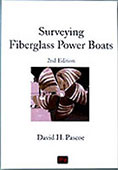






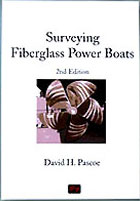

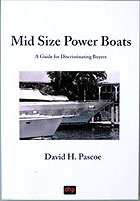
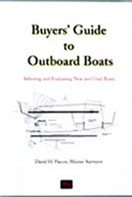

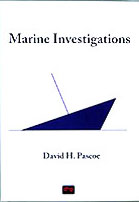
David Pascoe is a second generation marine surveyor in his family who began his surveying career at age 16 as an apprentice in 1965 as the era of wooden boats was drawing to a close.
Certified by the National Association of Marine Surveyors in 1972, he has conducted over 5,000 pre purchase surveys in addition to having conducted hundreds of boating accident investigations, including fires, sinkings, hull failures and machinery failure analysis.
Over forty years of knowledge and experience are brought to bear in following books. David Pascoe is the author of:
In addition to readers in the United States, boaters and boat industry professionals worldwide from nearly 80 countries have purchased David Pascoe's books, since introduction of his first book in 2001.
In 2012, David Pascoe has retired from marine surveying business at age 65.
On November 23rd, 2018, David Pascoe has passed away at age 71.
Biography - Long version